Coursework Assignment 3 (992): Limited Liability and Risk Analysis
VerifiedAdded on 2023/03/20
|8
|3434
|54
Homework Assignment
AI Summary
This coursework assignment analyzes the concept of limited liability, exploring its implications for businesses and the economy. It delves into the advantages and disadvantages of limited liability, discussing how it impacts risk-taking, investment, and market dynamics. The assignment further examines property risks, including physical damage to infrastructure, and business interruption, focusing on direct physical loss scenarios and the role of insurance in mitigating these risks. The analysis covers various risk events, such as fires, adverse weather, and terrorism, and their impact on business operations. The assignment also explores legal and customary law aspects related to risk management, including the role of insurance services and court decisions. The coursework references various academic sources to support the analysis and provides insights into the challenges and strategies related to business risk management.
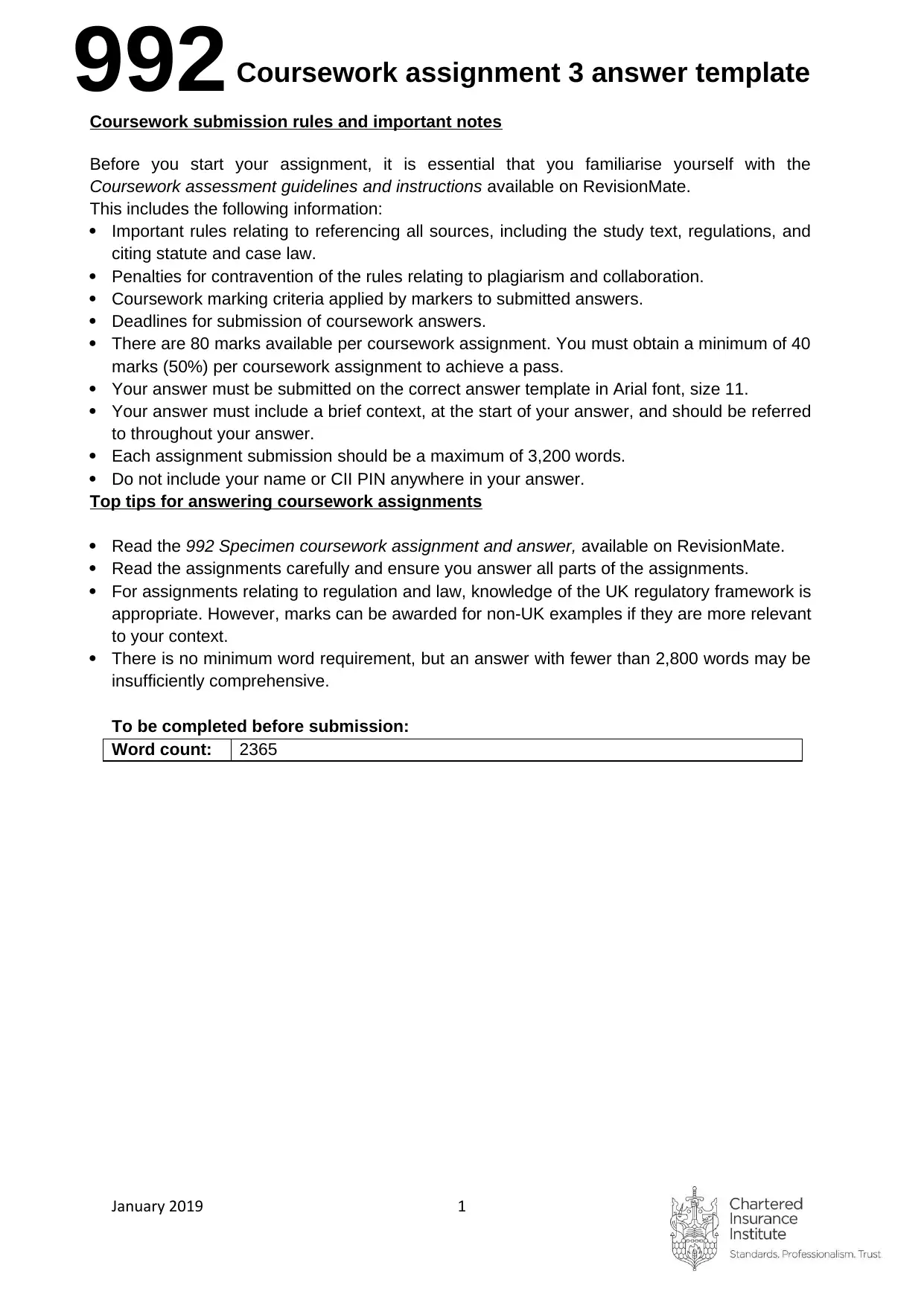
Coursework assignment 3 answer template992Coursework submission rules and important notes
Before you start your assignment, it is essential that you familiarise yourself with the
Coursework assessment guidelines and instructions available on RevisionMate.
This includes the following information:
Important rules relating to referencing all sources, including the study text, regulations, and
citing statute and case law.
Penalties for contravention of the rules relating to plagiarism and collaboration.
Coursework marking criteria applied by markers to submitted answers.
Deadlines for submission of coursework answers.
There are 80 marks available per coursework assignment. You must obtain a minimum of 40
marks (50%) per coursework assignment to achieve a pass.
Your answer must be submitted on the correct answer template in Arial font, size 11.
Your answer must include a brief context, at the start of your answer, and should be referred
to throughout your answer.
Each assignment submission should be a maximum of 3,200 words.
Do not include your name or CII PIN anywhere in your answer.
Top tips for answering coursework assignments
Read the 992 Specimen coursework assignment and answer, available on RevisionMate.
Read the assignments carefully and ensure you answer all parts of the assignments.
For assignments relating to regulation and law, knowledge of the UK regulatory framework is
appropriate. However, marks can be awarded for non-UK examples if they are more relevant
to your context.
There is no minimum word requirement, but an answer with fewer than 2,800 words may be
insufficiently comprehensive.
To be completed before submission:
Word count: 2365
January 2019 1
Before you start your assignment, it is essential that you familiarise yourself with the
Coursework assessment guidelines and instructions available on RevisionMate.
This includes the following information:
Important rules relating to referencing all sources, including the study text, regulations, and
citing statute and case law.
Penalties for contravention of the rules relating to plagiarism and collaboration.
Coursework marking criteria applied by markers to submitted answers.
Deadlines for submission of coursework answers.
There are 80 marks available per coursework assignment. You must obtain a minimum of 40
marks (50%) per coursework assignment to achieve a pass.
Your answer must be submitted on the correct answer template in Arial font, size 11.
Your answer must include a brief context, at the start of your answer, and should be referred
to throughout your answer.
Each assignment submission should be a maximum of 3,200 words.
Do not include your name or CII PIN anywhere in your answer.
Top tips for answering coursework assignments
Read the 992 Specimen coursework assignment and answer, available on RevisionMate.
Read the assignments carefully and ensure you answer all parts of the assignments.
For assignments relating to regulation and law, knowledge of the UK regulatory framework is
appropriate. However, marks can be awarded for non-UK examples if they are more relevant
to your context.
There is no minimum word requirement, but an answer with fewer than 2,800 words may be
insufficiently comprehensive.
To be completed before submission:
Word count: 2365
January 2019 1
Paraphrase This Document
Need a fresh take? Get an instant paraphrase of this document with our AI Paraphraser
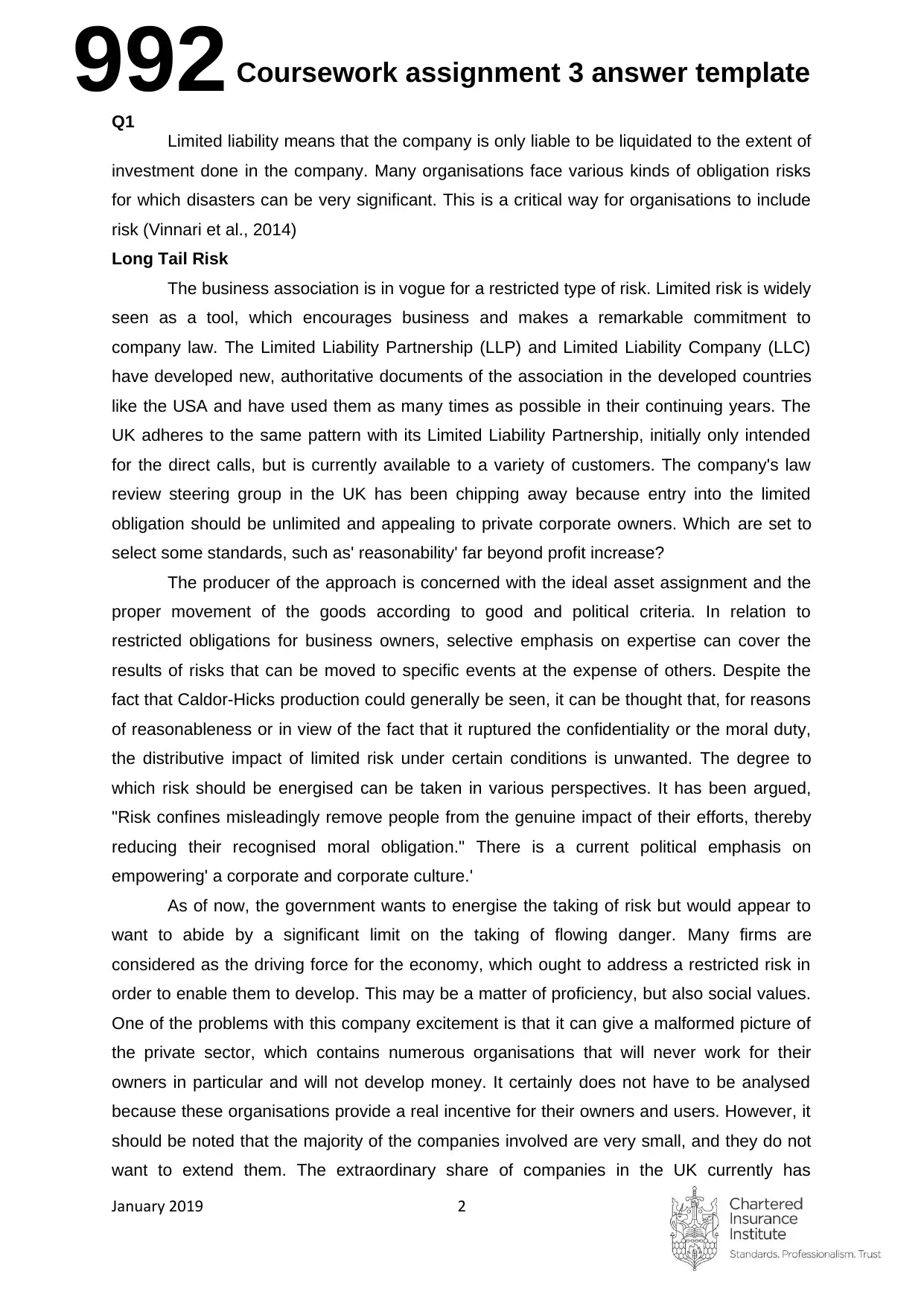
992Coursework assignment 3 answer template
Q1
Limited liability means that the company is only liable to be liquidated to the extent of
investment done in the company. Many organisations face various kinds of obligation risks
for which disasters can be very significant. This is a critical way for organisations to include
risk (Vinnari et al., 2014)
Long Tail Risk
The business association is in vogue for a restricted type of risk. Limited risk is widely
seen as a tool, which encourages business and makes a remarkable commitment to
company law. The Limited Liability Partnership (LLP) and Limited Liability Company (LLC)
have developed new, authoritative documents of the association in the developed countries
like the USA and have used them as many times as possible in their continuing years. The
UK adheres to the same pattern with its Limited Liability Partnership, initially only intended
for the direct calls, but is currently available to a variety of customers. The company's law
review steering group in the UK has been chipping away because entry into the limited
obligation should be unlimited and appealing to private corporate owners. Which are set to
select some standards, such as' reasonability' far beyond profit increase?
The producer of the approach is concerned with the ideal asset assignment and the
proper movement of the goods according to good and political criteria. In relation to
restricted obligations for business owners, selective emphasis on expertise can cover the
results of risks that can be moved to specific events at the expense of others. Despite the
fact that Caldor-Hicks production could generally be seen, it can be thought that, for reasons
of reasonableness or in view of the fact that it ruptured the confidentiality or the moral duty,
the distributive impact of limited risk under certain conditions is unwanted. The degree to
which risk should be energised can be taken in various perspectives. It has been argued,
"Risk confines misleadingly remove people from the genuine impact of their efforts, thereby
reducing their recognised moral obligation." There is a current political emphasis on
empowering' a corporate and corporate culture.'
As of now, the government wants to energise the taking of risk but would appear to
want to abide by a significant limit on the taking of flowing danger. Many firms are
considered as the driving force for the economy, which ought to address a restricted risk in
order to enable them to develop. This may be a matter of proficiency, but also social values.
One of the problems with this company excitement is that it can give a malformed picture of
the private sector, which contains numerous organisations that will never work for their
owners in particular and will not develop money. It certainly does not have to be analysed
because these organisations provide a real incentive for their owners and users. However, it
should be noted that the majority of the companies involved are very small, and they do not
want to extend them. The extraordinary share of companies in the UK currently has
January 2019 2
Q1
Limited liability means that the company is only liable to be liquidated to the extent of
investment done in the company. Many organisations face various kinds of obligation risks
for which disasters can be very significant. This is a critical way for organisations to include
risk (Vinnari et al., 2014)
Long Tail Risk
The business association is in vogue for a restricted type of risk. Limited risk is widely
seen as a tool, which encourages business and makes a remarkable commitment to
company law. The Limited Liability Partnership (LLP) and Limited Liability Company (LLC)
have developed new, authoritative documents of the association in the developed countries
like the USA and have used them as many times as possible in their continuing years. The
UK adheres to the same pattern with its Limited Liability Partnership, initially only intended
for the direct calls, but is currently available to a variety of customers. The company's law
review steering group in the UK has been chipping away because entry into the limited
obligation should be unlimited and appealing to private corporate owners. Which are set to
select some standards, such as' reasonability' far beyond profit increase?
The producer of the approach is concerned with the ideal asset assignment and the
proper movement of the goods according to good and political criteria. In relation to
restricted obligations for business owners, selective emphasis on expertise can cover the
results of risks that can be moved to specific events at the expense of others. Despite the
fact that Caldor-Hicks production could generally be seen, it can be thought that, for reasons
of reasonableness or in view of the fact that it ruptured the confidentiality or the moral duty,
the distributive impact of limited risk under certain conditions is unwanted. The degree to
which risk should be energised can be taken in various perspectives. It has been argued,
"Risk confines misleadingly remove people from the genuine impact of their efforts, thereby
reducing their recognised moral obligation." There is a current political emphasis on
empowering' a corporate and corporate culture.'
As of now, the government wants to energise the taking of risk but would appear to
want to abide by a significant limit on the taking of flowing danger. Many firms are
considered as the driving force for the economy, which ought to address a restricted risk in
order to enable them to develop. This may be a matter of proficiency, but also social values.
One of the problems with this company excitement is that it can give a malformed picture of
the private sector, which contains numerous organisations that will never work for their
owners in particular and will not develop money. It certainly does not have to be analysed
because these organisations provide a real incentive for their owners and users. However, it
should be noted that the majority of the companies involved are very small, and they do not
want to extend them. The extraordinary share of companies in the UK currently has
January 2019 2
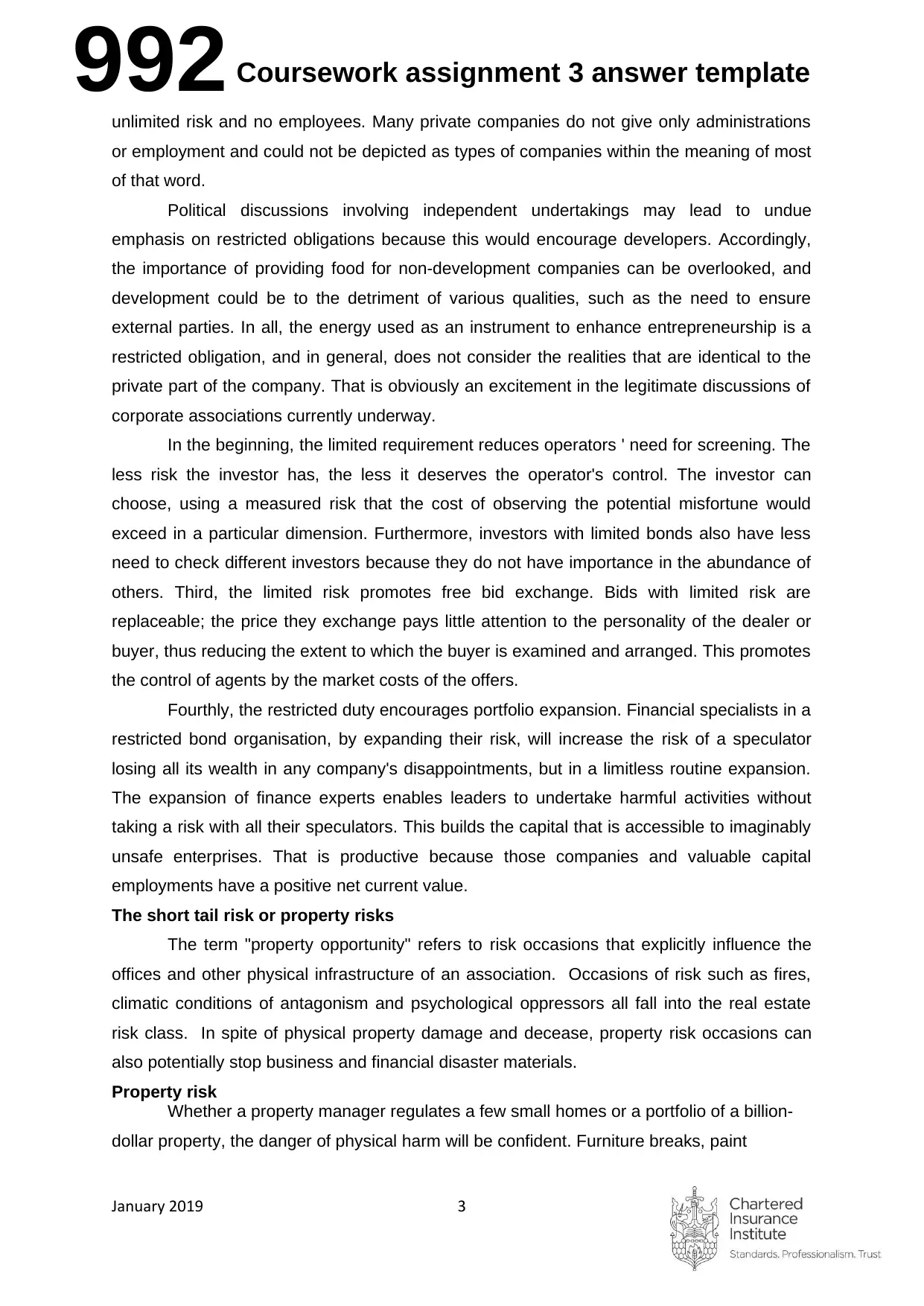
992Coursework assignment 3 answer template
unlimited risk and no employees. Many private companies do not give only administrations
or employment and could not be depicted as types of companies within the meaning of most
of that word.
Political discussions involving independent undertakings may lead to undue
emphasis on restricted obligations because this would encourage developers. Accordingly,
the importance of providing food for non-development companies can be overlooked, and
development could be to the detriment of various qualities, such as the need to ensure
external parties. In all, the energy used as an instrument to enhance entrepreneurship is a
restricted obligation, and in general, does not consider the realities that are identical to the
private part of the company. That is obviously an excitement in the legitimate discussions of
corporate associations currently underway.
In the beginning, the limited requirement reduces operators ' need for screening. The
less risk the investor has, the less it deserves the operator's control. The investor can
choose, using a measured risk that the cost of observing the potential misfortune would
exceed in a particular dimension. Furthermore, investors with limited bonds also have less
need to check different investors because they do not have importance in the abundance of
others. Third, the limited risk promotes free bid exchange. Bids with limited risk are
replaceable; the price they exchange pays little attention to the personality of the dealer or
buyer, thus reducing the extent to which the buyer is examined and arranged. This promotes
the control of agents by the market costs of the offers.
Fourthly, the restricted duty encourages portfolio expansion. Financial specialists in a
restricted bond organisation, by expanding their risk, will increase the risk of a speculator
losing all its wealth in any company's disappointments, but in a limitless routine expansion.
The expansion of finance experts enables leaders to undertake harmful activities without
taking a risk with all their speculators. This builds the capital that is accessible to imaginably
unsafe enterprises. That is productive because those companies and valuable capital
employments have a positive net current value.
The short tail risk or property risks
The term "property opportunity" refers to risk occasions that explicitly influence the
offices and other physical infrastructure of an association. Occasions of risk such as fires,
climatic conditions of antagonism and psychological oppressors all fall into the real estate
risk class. In spite of physical property damage and decease, property risk occasions can
also potentially stop business and financial disaster materials.
Property risk
Whether a property manager regulates a few small homes or a portfolio of a billion-
dollar property, the danger of physical harm will be confident. Furniture breaks, paint
January 2019 3
unlimited risk and no employees. Many private companies do not give only administrations
or employment and could not be depicted as types of companies within the meaning of most
of that word.
Political discussions involving independent undertakings may lead to undue
emphasis on restricted obligations because this would encourage developers. Accordingly,
the importance of providing food for non-development companies can be overlooked, and
development could be to the detriment of various qualities, such as the need to ensure
external parties. In all, the energy used as an instrument to enhance entrepreneurship is a
restricted obligation, and in general, does not consider the realities that are identical to the
private part of the company. That is obviously an excitement in the legitimate discussions of
corporate associations currently underway.
In the beginning, the limited requirement reduces operators ' need for screening. The
less risk the investor has, the less it deserves the operator's control. The investor can
choose, using a measured risk that the cost of observing the potential misfortune would
exceed in a particular dimension. Furthermore, investors with limited bonds also have less
need to check different investors because they do not have importance in the abundance of
others. Third, the limited risk promotes free bid exchange. Bids with limited risk are
replaceable; the price they exchange pays little attention to the personality of the dealer or
buyer, thus reducing the extent to which the buyer is examined and arranged. This promotes
the control of agents by the market costs of the offers.
Fourthly, the restricted duty encourages portfolio expansion. Financial specialists in a
restricted bond organisation, by expanding their risk, will increase the risk of a speculator
losing all its wealth in any company's disappointments, but in a limitless routine expansion.
The expansion of finance experts enables leaders to undertake harmful activities without
taking a risk with all their speculators. This builds the capital that is accessible to imaginably
unsafe enterprises. That is productive because those companies and valuable capital
employments have a positive net current value.
The short tail risk or property risks
The term "property opportunity" refers to risk occasions that explicitly influence the
offices and other physical infrastructure of an association. Occasions of risk such as fires,
climatic conditions of antagonism and psychological oppressors all fall into the real estate
risk class. In spite of physical property damage and decease, property risk occasions can
also potentially stop business and financial disaster materials.
Property risk
Whether a property manager regulates a few small homes or a portfolio of a billion-
dollar property, the danger of physical harm will be confident. Furniture breaks, paint
January 2019 3
⊘ This is a preview!⊘
Do you want full access?
Subscribe today to unlock all pages.

Trusted by 1+ million students worldwide
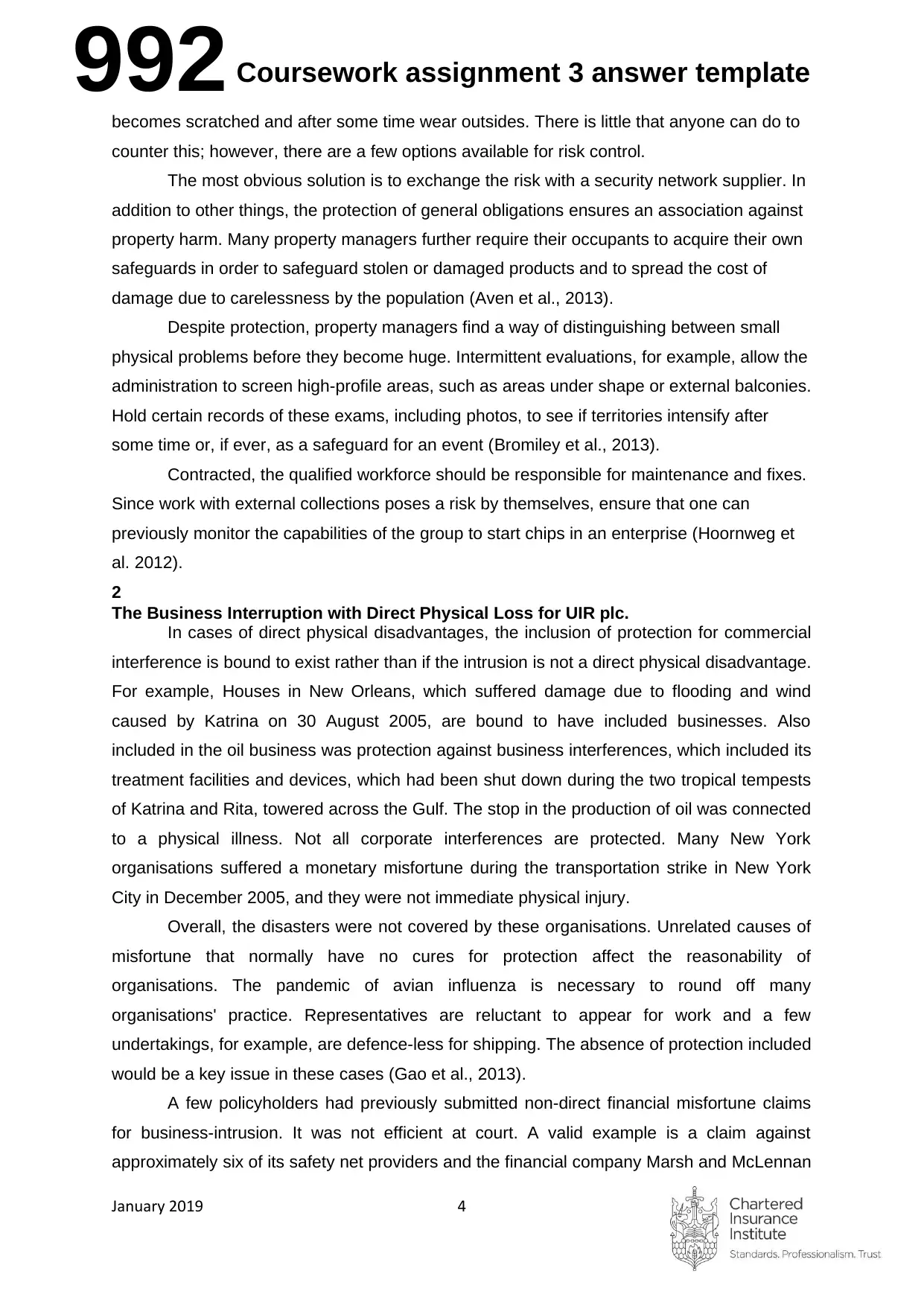
992Coursework assignment 3 answer template
becomes scratched and after some time wear outsides. There is little that anyone can do to
counter this; however, there are a few options available for risk control.
The most obvious solution is to exchange the risk with a security network supplier. In
addition to other things, the protection of general obligations ensures an association against
property harm. Many property managers further require their occupants to acquire their own
safeguards in order to safeguard stolen or damaged products and to spread the cost of
damage due to carelessness by the population (Aven et al., 2013).
Despite protection, property managers find a way of distinguishing between small
physical problems before they become huge. Intermittent evaluations, for example, allow the
administration to screen high-profile areas, such as areas under shape or external balconies.
Hold certain records of these exams, including photos, to see if territories intensify after
some time or, if ever, as a safeguard for an event (Bromiley et al., 2013).
Contracted, the qualified workforce should be responsible for maintenance and fixes.
Since work with external collections poses a risk by themselves, ensure that one can
previously monitor the capabilities of the group to start chips in an enterprise (Hoornweg et
al. 2012).
2
The Business Interruption with Direct Physical Loss for UIR plc.
In cases of direct physical disadvantages, the inclusion of protection for commercial
interference is bound to exist rather than if the intrusion is not a direct physical disadvantage.
For example, Houses in New Orleans, which suffered damage due to flooding and wind
caused by Katrina on 30 August 2005, are bound to have included businesses. Also
included in the oil business was protection against business interferences, which included its
treatment facilities and devices, which had been shut down during the two tropical tempests
of Katrina and Rita, towered across the Gulf. The stop in the production of oil was connected
to a physical illness. Not all corporate interferences are protected. Many New York
organisations suffered a monetary misfortune during the transportation strike in New York
City in December 2005, and they were not immediate physical injury.
Overall, the disasters were not covered by these organisations. Unrelated causes of
misfortune that normally have no cures for protection affect the reasonability of
organisations. The pandemic of avian influenza is necessary to round off many
organisations' practice. Representatives are reluctant to appear for work and a few
undertakings, for example, are defence-less for shipping. The absence of protection included
would be a key issue in these cases (Gao et al., 2013).
A few policyholders had previously submitted non-direct financial misfortune claims
for business-intrusion. It was not efficient at court. A valid example is a claim against
approximately six of its safety net providers and the financial company Marsh and McLennan
January 2019 4
becomes scratched and after some time wear outsides. There is little that anyone can do to
counter this; however, there are a few options available for risk control.
The most obvious solution is to exchange the risk with a security network supplier. In
addition to other things, the protection of general obligations ensures an association against
property harm. Many property managers further require their occupants to acquire their own
safeguards in order to safeguard stolen or damaged products and to spread the cost of
damage due to carelessness by the population (Aven et al., 2013).
Despite protection, property managers find a way of distinguishing between small
physical problems before they become huge. Intermittent evaluations, for example, allow the
administration to screen high-profile areas, such as areas under shape or external balconies.
Hold certain records of these exams, including photos, to see if territories intensify after
some time or, if ever, as a safeguard for an event (Bromiley et al., 2013).
Contracted, the qualified workforce should be responsible for maintenance and fixes.
Since work with external collections poses a risk by themselves, ensure that one can
previously monitor the capabilities of the group to start chips in an enterprise (Hoornweg et
al. 2012).
2
The Business Interruption with Direct Physical Loss for UIR plc.
In cases of direct physical disadvantages, the inclusion of protection for commercial
interference is bound to exist rather than if the intrusion is not a direct physical disadvantage.
For example, Houses in New Orleans, which suffered damage due to flooding and wind
caused by Katrina on 30 August 2005, are bound to have included businesses. Also
included in the oil business was protection against business interferences, which included its
treatment facilities and devices, which had been shut down during the two tropical tempests
of Katrina and Rita, towered across the Gulf. The stop in the production of oil was connected
to a physical illness. Not all corporate interferences are protected. Many New York
organisations suffered a monetary misfortune during the transportation strike in New York
City in December 2005, and they were not immediate physical injury.
Overall, the disasters were not covered by these organisations. Unrelated causes of
misfortune that normally have no cures for protection affect the reasonability of
organisations. The pandemic of avian influenza is necessary to round off many
organisations' practice. Representatives are reluctant to appear for work and a few
undertakings, for example, are defence-less for shipping. The absence of protection included
would be a key issue in these cases (Gao et al., 2013).
A few policyholders had previously submitted non-direct financial misfortune claims
for business-intrusion. It was not efficient at court. A valid example is a claim against
approximately six of its safety net providers and the financial company Marsh and McLennan
January 2019 4
Paraphrase This Document
Need a fresh take? Get an instant paraphrase of this document with our AI Paraphraser
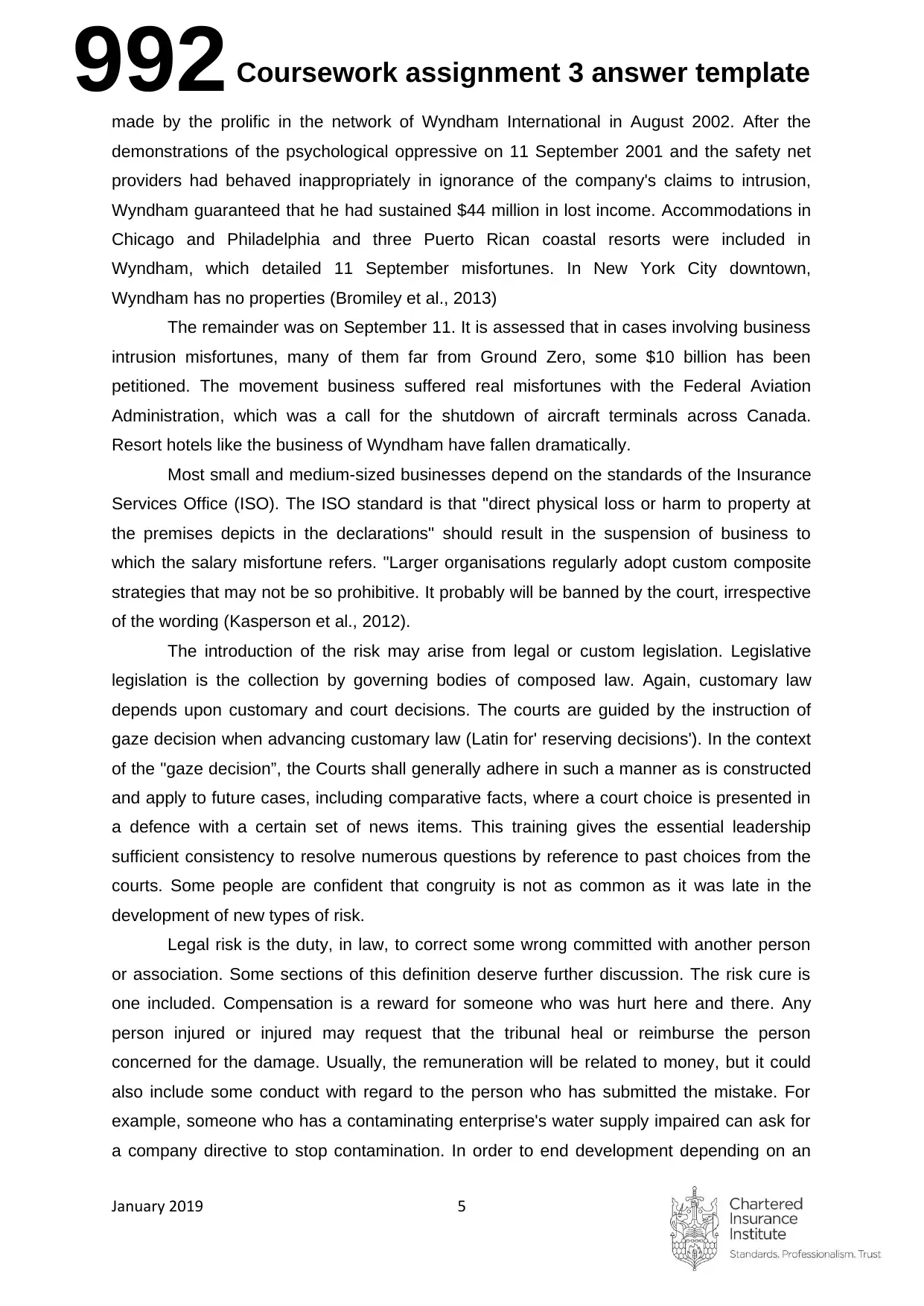
992Coursework assignment 3 answer template
made by the prolific in the network of Wyndham International in August 2002. After the
demonstrations of the psychological oppressive on 11 September 2001 and the safety net
providers had behaved inappropriately in ignorance of the company's claims to intrusion,
Wyndham guaranteed that he had sustained $44 million in lost income. Accommodations in
Chicago and Philadelphia and three Puerto Rican coastal resorts were included in
Wyndham, which detailed 11 September misfortunes. In New York City downtown,
Wyndham has no properties (Bromiley et al., 2013)
The remainder was on September 11. It is assessed that in cases involving business
intrusion misfortunes, many of them far from Ground Zero, some $10 billion has been
petitioned. The movement business suffered real misfortunes with the Federal Aviation
Administration, which was a call for the shutdown of aircraft terminals across Canada.
Resort hotels like the business of Wyndham have fallen dramatically.
Most small and medium-sized businesses depend on the standards of the Insurance
Services Office (ISO). The ISO standard is that "direct physical loss or harm to property at
the premises depicts in the declarations" should result in the suspension of business to
which the salary misfortune refers. "Larger organisations regularly adopt custom composite
strategies that may not be so prohibitive. It probably will be banned by the court, irrespective
of the wording (Kasperson et al., 2012).
The introduction of the risk may arise from legal or custom legislation. Legislative
legislation is the collection by governing bodies of composed law. Again, customary law
depends upon customary and court decisions. The courts are guided by the instruction of
gaze decision when advancing customary law (Latin for' reserving decisions'). In the context
of the "gaze decision”, the Courts shall generally adhere in such a manner as is constructed
and apply to future cases, including comparative facts, where a court choice is presented in
a defence with a certain set of news items. This training gives the essential leadership
sufficient consistency to resolve numerous questions by reference to past choices from the
courts. Some people are confident that congruity is not as common as it was late in the
development of new types of risk.
Legal risk is the duty, in law, to correct some wrong committed with another person
or association. Some sections of this definition deserve further discussion. The risk cure is
one included. Compensation is a reward for someone who was hurt here and there. Any
person injured or injured may request that the tribunal heal or reimburse the person
concerned for the damage. Usually, the remuneration will be related to money, but it could
also include some conduct with regard to the person who has submitted the mistake. For
example, someone who has a contaminating enterprise's water supply impaired can ask for
a company directive to stop contamination. In order to end development depending on an
January 2019 5
made by the prolific in the network of Wyndham International in August 2002. After the
demonstrations of the psychological oppressive on 11 September 2001 and the safety net
providers had behaved inappropriately in ignorance of the company's claims to intrusion,
Wyndham guaranteed that he had sustained $44 million in lost income. Accommodations in
Chicago and Philadelphia and three Puerto Rican coastal resorts were included in
Wyndham, which detailed 11 September misfortunes. In New York City downtown,
Wyndham has no properties (Bromiley et al., 2013)
The remainder was on September 11. It is assessed that in cases involving business
intrusion misfortunes, many of them far from Ground Zero, some $10 billion has been
petitioned. The movement business suffered real misfortunes with the Federal Aviation
Administration, which was a call for the shutdown of aircraft terminals across Canada.
Resort hotels like the business of Wyndham have fallen dramatically.
Most small and medium-sized businesses depend on the standards of the Insurance
Services Office (ISO). The ISO standard is that "direct physical loss or harm to property at
the premises depicts in the declarations" should result in the suspension of business to
which the salary misfortune refers. "Larger organisations regularly adopt custom composite
strategies that may not be so prohibitive. It probably will be banned by the court, irrespective
of the wording (Kasperson et al., 2012).
The introduction of the risk may arise from legal or custom legislation. Legislative
legislation is the collection by governing bodies of composed law. Again, customary law
depends upon customary and court decisions. The courts are guided by the instruction of
gaze decision when advancing customary law (Latin for' reserving decisions'). In the context
of the "gaze decision”, the Courts shall generally adhere in such a manner as is constructed
and apply to future cases, including comparative facts, where a court choice is presented in
a defence with a certain set of news items. This training gives the essential leadership
sufficient consistency to resolve numerous questions by reference to past choices from the
courts. Some people are confident that congruity is not as common as it was late in the
development of new types of risk.
Legal risk is the duty, in law, to correct some wrong committed with another person
or association. Some sections of this definition deserve further discussion. The risk cure is
one included. Compensation is a reward for someone who was hurt here and there. Any
person injured or injured may request that the tribunal heal or reimburse the person
concerned for the damage. Usually, the remuneration will be related to money, but it could
also include some conduct with regard to the person who has submitted the mistake. For
example, someone who has a contaminating enterprise's water supply impaired can ask for
a company directive to stop contamination. In order to end development depending on an
January 2019 5
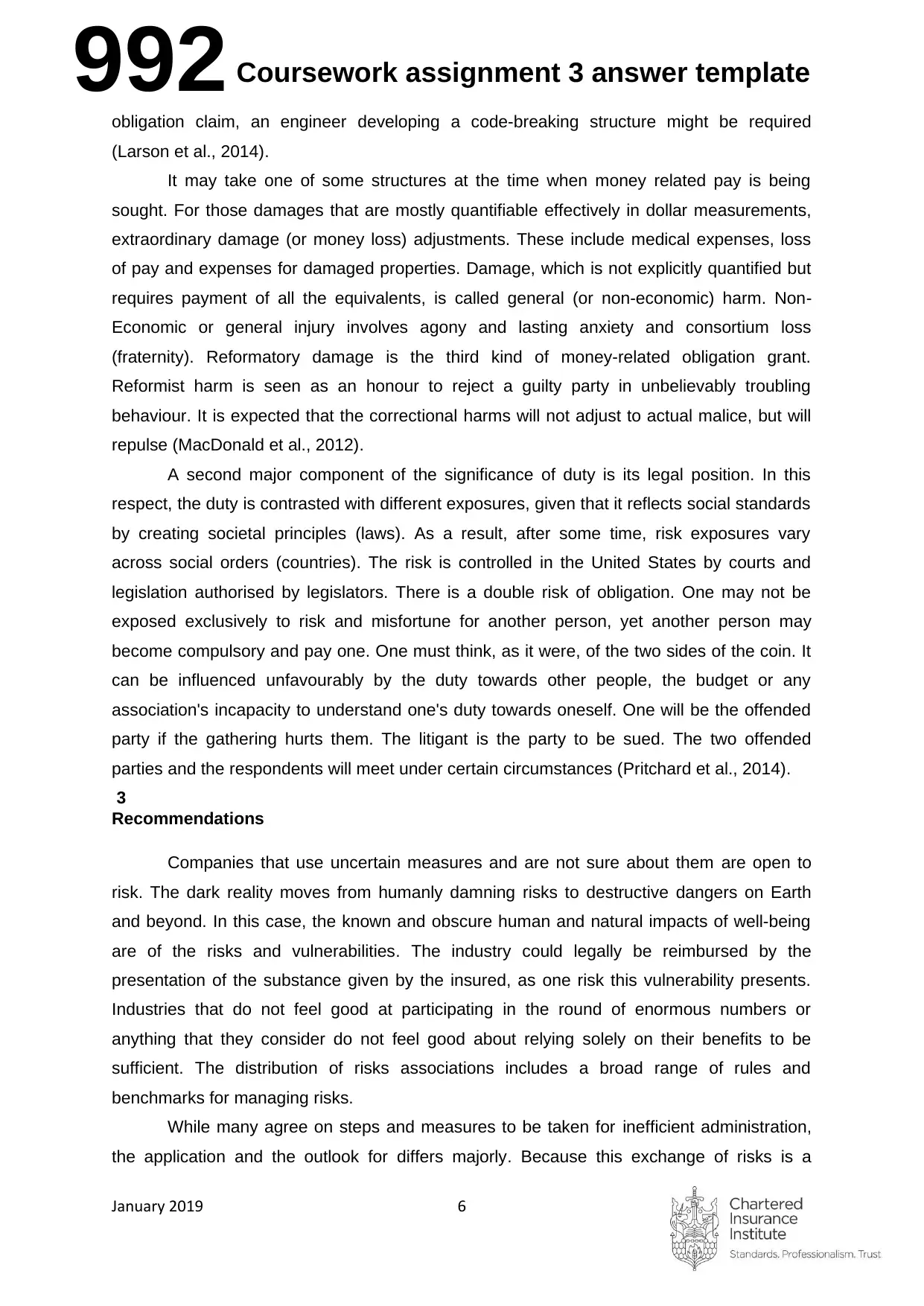
992Coursework assignment 3 answer template
obligation claim, an engineer developing a code-breaking structure might be required
(Larson et al., 2014).
It may take one of some structures at the time when money related pay is being
sought. For those damages that are mostly quantifiable effectively in dollar measurements,
extraordinary damage (or money loss) adjustments. These include medical expenses, loss
of pay and expenses for damaged properties. Damage, which is not explicitly quantified but
requires payment of all the equivalents, is called general (or non-economic) harm. Non-
Economic or general injury involves agony and lasting anxiety and consortium loss
(fraternity). Reformatory damage is the third kind of money-related obligation grant.
Reformist harm is seen as an honour to reject a guilty party in unbelievably troubling
behaviour. It is expected that the correctional harms will not adjust to actual malice, but will
repulse (MacDonald et al., 2012).
A second major component of the significance of duty is its legal position. In this
respect, the duty is contrasted with different exposures, given that it reflects social standards
by creating societal principles (laws). As a result, after some time, risk exposures vary
across social orders (countries). The risk is controlled in the United States by courts and
legislation authorised by legislators. There is a double risk of obligation. One may not be
exposed exclusively to risk and misfortune for another person, yet another person may
become compulsory and pay one. One must think, as it were, of the two sides of the coin. It
can be influenced unfavourably by the duty towards other people, the budget or any
association's incapacity to understand one's duty towards oneself. One will be the offended
party if the gathering hurts them. The litigant is the party to be sued. The two offended
parties and the respondents will meet under certain circumstances (Pritchard et al., 2014).
3
Recommendations
Companies that use uncertain measures and are not sure about them are open to
risk. The dark reality moves from humanly damning risks to destructive dangers on Earth
and beyond. In this case, the known and obscure human and natural impacts of well-being
are of the risks and vulnerabilities. The industry could legally be reimbursed by the
presentation of the substance given by the insured, as one risk this vulnerability presents.
Industries that do not feel good at participating in the round of enormous numbers or
anything that they consider do not feel good about relying solely on their benefits to be
sufficient. The distribution of risks associations includes a broad range of rules and
benchmarks for managing risks.
While many agree on steps and measures to be taken for inefficient administration,
the application and the outlook for differs majorly. Because this exchange of risks is a
January 2019 6
obligation claim, an engineer developing a code-breaking structure might be required
(Larson et al., 2014).
It may take one of some structures at the time when money related pay is being
sought. For those damages that are mostly quantifiable effectively in dollar measurements,
extraordinary damage (or money loss) adjustments. These include medical expenses, loss
of pay and expenses for damaged properties. Damage, which is not explicitly quantified but
requires payment of all the equivalents, is called general (or non-economic) harm. Non-
Economic or general injury involves agony and lasting anxiety and consortium loss
(fraternity). Reformatory damage is the third kind of money-related obligation grant.
Reformist harm is seen as an honour to reject a guilty party in unbelievably troubling
behaviour. It is expected that the correctional harms will not adjust to actual malice, but will
repulse (MacDonald et al., 2012).
A second major component of the significance of duty is its legal position. In this
respect, the duty is contrasted with different exposures, given that it reflects social standards
by creating societal principles (laws). As a result, after some time, risk exposures vary
across social orders (countries). The risk is controlled in the United States by courts and
legislation authorised by legislators. There is a double risk of obligation. One may not be
exposed exclusively to risk and misfortune for another person, yet another person may
become compulsory and pay one. One must think, as it were, of the two sides of the coin. It
can be influenced unfavourably by the duty towards other people, the budget or any
association's incapacity to understand one's duty towards oneself. One will be the offended
party if the gathering hurts them. The litigant is the party to be sued. The two offended
parties and the respondents will meet under certain circumstances (Pritchard et al., 2014).
3
Recommendations
Companies that use uncertain measures and are not sure about them are open to
risk. The dark reality moves from humanly damning risks to destructive dangers on Earth
and beyond. In this case, the known and obscure human and natural impacts of well-being
are of the risks and vulnerabilities. The industry could legally be reimbursed by the
presentation of the substance given by the insured, as one risk this vulnerability presents.
Industries that do not feel good at participating in the round of enormous numbers or
anything that they consider do not feel good about relying solely on their benefits to be
sufficient. The distribution of risks associations includes a broad range of rules and
benchmarks for managing risks.
While many agree on steps and measures to be taken for inefficient administration,
the application and the outlook for differs majorly. Because this exchange of risks is a
January 2019 6
⊘ This is a preview!⊘
Do you want full access?
Subscribe today to unlock all pages.

Trusted by 1+ million students worldwide
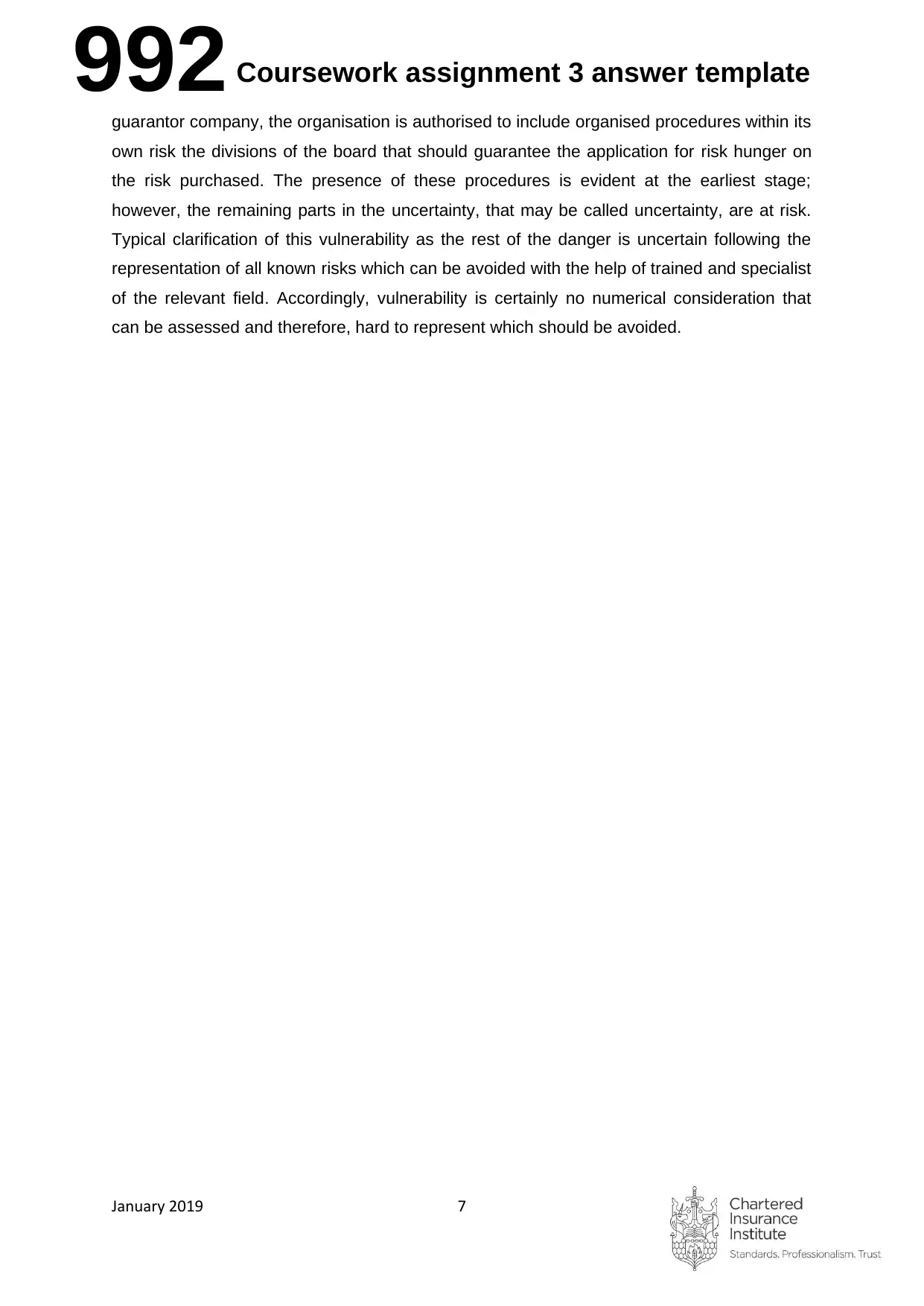
992Coursework assignment 3 answer template
guarantor company, the organisation is authorised to include organised procedures within its
own risk the divisions of the board that should guarantee the application for risk hunger on
the risk purchased. The presence of these procedures is evident at the earliest stage;
however, the remaining parts in the uncertainty, that may be called uncertainty, are at risk.
Typical clarification of this vulnerability as the rest of the danger is uncertain following the
representation of all known risks which can be avoided with the help of trained and specialist
of the relevant field. Accordingly, vulnerability is certainly no numerical consideration that
can be assessed and therefore, hard to represent which should be avoided.
January 2019 7
guarantor company, the organisation is authorised to include organised procedures within its
own risk the divisions of the board that should guarantee the application for risk hunger on
the risk purchased. The presence of these procedures is evident at the earliest stage;
however, the remaining parts in the uncertainty, that may be called uncertainty, are at risk.
Typical clarification of this vulnerability as the rest of the danger is uncertain following the
representation of all known risks which can be avoided with the help of trained and specialist
of the relevant field. Accordingly, vulnerability is certainly no numerical consideration that
can be assessed and therefore, hard to represent which should be avoided.
January 2019 7
Paraphrase This Document
Need a fresh take? Get an instant paraphrase of this document with our AI Paraphraser
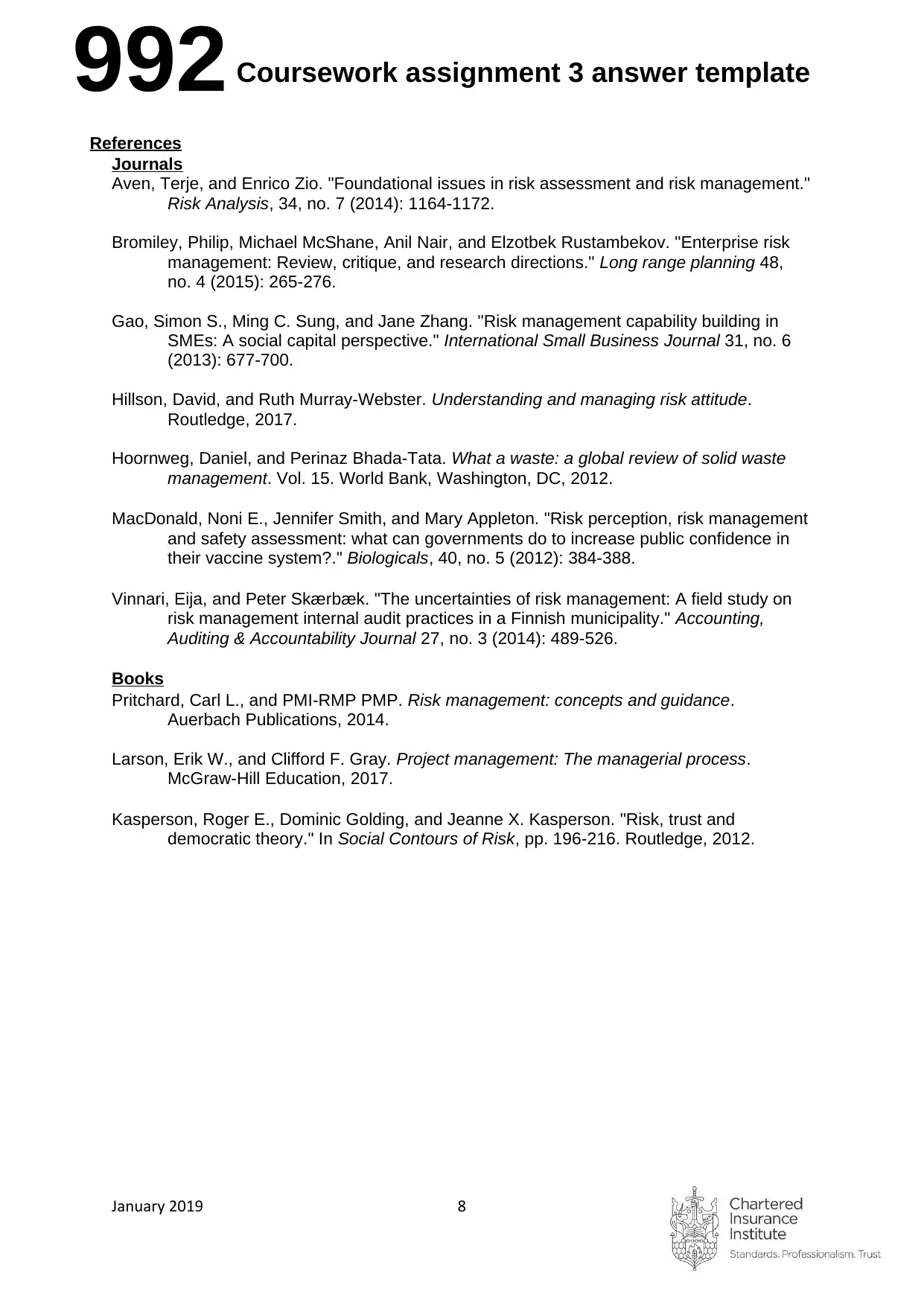
992Coursework assignment 3 answer template
References
Journals
Aven, Terje, and Enrico Zio. "Foundational issues in risk assessment and risk management."
Risk Analysis, 34, no. 7 (2014): 1164-1172.
Bromiley, Philip, Michael McShane, Anil Nair, and Elzotbek Rustambekov. "Enterprise risk
management: Review, critique, and research directions." Long range planning 48,
no. 4 (2015): 265-276.
Gao, Simon S., Ming C. Sung, and Jane Zhang. "Risk management capability building in
SMEs: A social capital perspective." International Small Business Journal 31, no. 6
(2013): 677-700.
Hillson, David, and Ruth Murray-Webster. Understanding and managing risk attitude.
Routledge, 2017.
Hoornweg, Daniel, and Perinaz Bhada-Tata. What a waste: a global review of solid waste
management. Vol. 15. World Bank, Washington, DC, 2012.
MacDonald, Noni E., Jennifer Smith, and Mary Appleton. "Risk perception, risk management
and safety assessment: what can governments do to increase public confidence in
their vaccine system?." Biologicals, 40, no. 5 (2012): 384-388.
Vinnari, Eija, and Peter Skærbæk. "The uncertainties of risk management: A field study on
risk management internal audit practices in a Finnish municipality." Accounting,
Auditing & Accountability Journal 27, no. 3 (2014): 489-526.
Books
Pritchard, Carl L., and PMI-RMP PMP. Risk management: concepts and guidance.
Auerbach Publications, 2014.
Larson, Erik W., and Clifford F. Gray. Project management: The managerial process.
McGraw-Hill Education, 2017.
Kasperson, Roger E., Dominic Golding, and Jeanne X. Kasperson. "Risk, trust and
democratic theory." In Social Contours of Risk, pp. 196-216. Routledge, 2012.
January 2019 8
References
Journals
Aven, Terje, and Enrico Zio. "Foundational issues in risk assessment and risk management."
Risk Analysis, 34, no. 7 (2014): 1164-1172.
Bromiley, Philip, Michael McShane, Anil Nair, and Elzotbek Rustambekov. "Enterprise risk
management: Review, critique, and research directions." Long range planning 48,
no. 4 (2015): 265-276.
Gao, Simon S., Ming C. Sung, and Jane Zhang. "Risk management capability building in
SMEs: A social capital perspective." International Small Business Journal 31, no. 6
(2013): 677-700.
Hillson, David, and Ruth Murray-Webster. Understanding and managing risk attitude.
Routledge, 2017.
Hoornweg, Daniel, and Perinaz Bhada-Tata. What a waste: a global review of solid waste
management. Vol. 15. World Bank, Washington, DC, 2012.
MacDonald, Noni E., Jennifer Smith, and Mary Appleton. "Risk perception, risk management
and safety assessment: what can governments do to increase public confidence in
their vaccine system?." Biologicals, 40, no. 5 (2012): 384-388.
Vinnari, Eija, and Peter Skærbæk. "The uncertainties of risk management: A field study on
risk management internal audit practices in a Finnish municipality." Accounting,
Auditing & Accountability Journal 27, no. 3 (2014): 489-526.
Books
Pritchard, Carl L., and PMI-RMP PMP. Risk management: concepts and guidance.
Auerbach Publications, 2014.
Larson, Erik W., and Clifford F. Gray. Project management: The managerial process.
McGraw-Hill Education, 2017.
Kasperson, Roger E., Dominic Golding, and Jeanne X. Kasperson. "Risk, trust and
democratic theory." In Social Contours of Risk, pp. 196-216. Routledge, 2012.
January 2019 8
1 out of 8
Related Documents
Your All-in-One AI-Powered Toolkit for Academic Success.
+13062052269
info@desklib.com
Available 24*7 on WhatsApp / Email
![[object Object]](/_next/static/media/star-bottom.7253800d.svg)
Unlock your academic potential
Copyright © 2020–2026 A2Z Services. All Rights Reserved. Developed and managed by ZUCOL.





